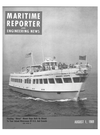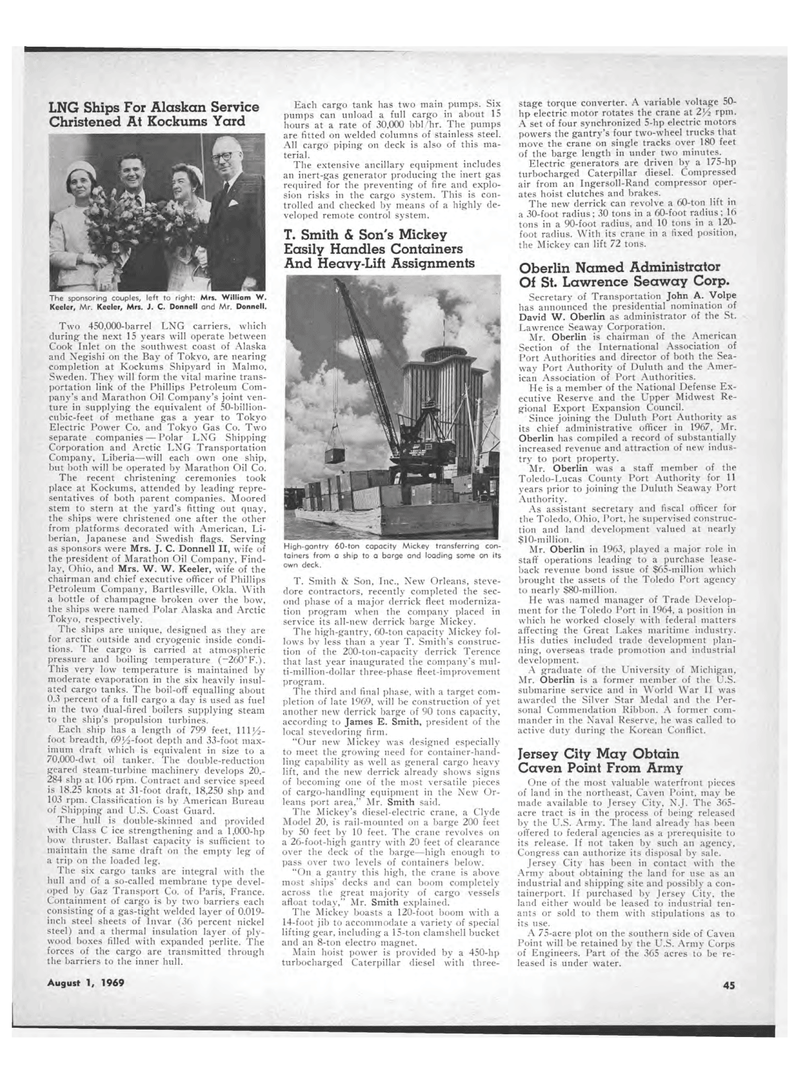
Page 43: of Maritime Reporter Magazine (August 1969)
Read this page in Pdf, Flash or Html5 edition of August 1969 Maritime Reporter Magazine
LNG Ships For Alaskan Service Christened At Kockums Yard II* ~ ' /4E9 f - i H JP mm V* a f iii Kjp mi i y^W* HrBH The sponsoring couples, left to right: Mrs. William W. Keeler, Mr. Keeler, Mrs. J. C. Donnell and Mr. Donneil. Two 450,000-barrel LNG carriers, which during' the next 15 years will operate between Cook Inlet on the southwest coast of Alaska and Negishi on the Bay of Tokvo, are nearing completion at Kockums Shipyard in Malmo, Sweden. They will form the vital marine trans-portation link of the Phillips Petroleum Com-pany's and Marathon Oil Company's joint ven-ture in supplying the equivalent of 50-billion-cubic-feet of methane gas a year to Tokyo Electric Power Co. and Tokyo Gas Co. Two separate companies ? Polar LNG Shipping Corporation and Arctic LNG Transportation Company, Liberia?will each own one ship, but both will be operated by Marathon Oil Co. The recent christening ceremonies took place at Kockums, attended by leading repre-sentatives of both parent companies. Moored stem to stern at the yard's fitting out quay, the ships were christened one after the other from platforms decorated with American, Li-berian, Japanese and Swedish flags. Serving as sponsors were Mrs. J. C. Donnell II, wife of the president of Marathon Oil Company, Find-lay, Ohio, and Mrs. W. W. Keeler, wife of the chairman and chief executive officer of Phillips Petroleum Company, Bartlesville, Okla. With a bottle of champagne broken over the bow, the ships were named Polar Alaska and Arctic Tokyo, respectively. The ships are unique, designed as they are for arctic outside and cryogenic inside condi-tions. The cargo is carried at atmospheric pressure and boiling temperature (-260°F.). This very low temperature is maintained by moderate evaporation in the six heavily insul-ated cargo tanks. The boil-off equalling about 0.3 percent of a full cargo a day is used as fuel in the two dual-fired boilers supplying steam to the ship's propulsion turbines. Each ship has a length of 799 feet, \\\y2-foot breadth, 69^-foot depth and 33-foot max-imum draft which is equivalent in size to a 70,000-dwt oil tanker. The double-reduction geared steam-turbine machinery develops 20,-284 slip at 106 rpm. Contract and service speed is 18.25 knots at 31-foot draft, 18,250 slip and 103 rpm. Classification is by American Bureau of Shipping and U.S. Coast Guard. The hull is double-skinned and provided with Class C ice strengthening and a 1,000-hp bow thruster. Ballast capacity is sufficient to maintain the same draft on the empty leg of a trip on the loaded leg. The six cargo tanks are integral with the hull and of a so-called membrane type devel-oped by Gaz Transport Co. of Paris, France. Containment of cargo is by two barriers each consisting of a gas-tight welded layer of 0.019-inch steel sheets of Invar (36 percent nickel steel) and a thermal insulation layer of ply-wood boxes filled with expanded perlite. The forces of the cargo are transmitted through the barriers to the inner hull. Each cargo tank has two main pumps. Six pumps can unload a full cargo in about 15 hours at a rate of 30,000 bbl/hr. The pumps are fitted on welded columns of stainless steel. All cargo piping on deck is also of this ma-terial. The extensive ancillary equipment includes an inert-gas generator producing the inert gas required for the preventing of fire and explo-sion risks in the cargo system. This is con-trolled and checked by means of a highly de-veloped remote control system. T. Smith & Son's Mickey Easily Handles Containers And Heavy-Lift Assignments T. Smith & Son, Inc., New Orleans, steve-dore contractors, recently completed the sec-ond phase of a major derrick fleet moderniza-tion program when the company placed in service its all-new derrick barge Mickey. The high-gantry, 60-ton capacity Mickey fol-lows by less than a year T. Smith's construc-tion of the 200-ton-capacity derrick Terence that last year inaugurated the company's mul-ti-million-dollar three-phase fleet-improvement program. The third and final phase, with a target com-pletion of late 1969, will be construction of yet another new derrick barge of 90 tons capacity, according to James E. Smith, president of the local stevedoring firm. "Our new Mickey was designed especially to meet the growing need for container-hand-ling capability as well as general cargo heavy lift, and the new derrick already shows signs of becoming one of the most versatile pieces of cargo-handling equipment in the New Or-leans port area," Mr. Smith said. The Mickey's diesel-electric crane, a Clyde Model 20, is rail-mounted on a barge 200 feet by 50 feet by 10 feet. The crane revolves on a 26-foot-high gantry with 20 feet of clearance over the deck of the barge?high enough to pass over two levels of containers below. "On a gantry this high, the crane is above most ships' decks and can boom completely across the great majority of cargo vessels afloat today," Mr. Smith explained. The Mickey boasts a 120-foot boom with a 14-foot jib to accommodate a variety of special lifting gear, including a 15-ton clamshell bucket and an 8-ton electro magnet. Main hoist power is provided by a 450-hp turbocharged Caterpillar diesel with three-stage torque converter. A variable voltage 50-hp electric motor rotates the crane at 2y2 rpm. A set of four synchronized 5-hp electric motors powers the gantry's four two-wheel trucks that move the crane on single tracks over 180 feet of the barge length in under two minutes. Electric generators are driven by a 175-hp turbocharged Caterpillar diesel. Compressed air from an Ingersoll-Rand compressor oper-ates hoist clutches and brakes. The new derrick can revolve a 60-ton lift in a 30-foot radius; 30 tons in a 60-foot radius; 16 tons in a 90-foot radius, and 10 tons in a 120-foot radius. With its crane in a fixed position, the Mickey can lift 72 tons. Oberlin Named Administrator Of St. Lawrence Seaway Corp. Secretary of Transportation John A. Volpe has announced the presidential nomination of David W. Oberlin as administrator of the St. Lawrence Seaway Corporation. Mr. Oberlin is chairman of the American Section of the International Association of Port Authorities and director of both the Sea-way Port Authority of Duluth and the Amer-ican Association of Port Authorities. He is a member of the National Defense Ex-ecutive Reserve and the Upper Midwest Re-gional Export Expansion Council. Since joining the Duluth Port Authority as its chief administrative officer in 1967, Mr. Oberlin has compiled a record of substantially increased revenue and attraction of new indus-try to port property. Mr. Oberlin was a staff member of the Toledo-Lucas County Port Authority for 11 years prior to joining the Duluth Seaway Port Authority. As assistant secretary and fiscal officer for the Toledo, Ohio, Port, he supervised construc-tion and land development valued at nearly $10-million. Mr. Oberlin in 1963, played a major role in staff operations leading to a purchase lease-back revenue bond issue of $65-million which brought the assets of the Toledo Port agency to nearly $80-million. Me was named manager of Trade Develop-ment for the Toledo Port in 1964, a position in which he worked closely with federal matters affecting the Great Lakes maritime industry. His duties included trade development plan-ning, overseas trade promotion and industrial development. A graduate of the University of Michigan, Mr. Oberlin is a former member of the U.S. submarine service and in World War II was awarded the Silver Star Medal and the Per-sonal Commendation Ribbon. A former com-mander in the Naval Reserve, he was called to active duty during the Korean Conflict. Jersey City May Obtain Caven Point From Army One of the most valuable waterfront pieces of land in the northeast, Caven Point, may be made available to Jersey City, N.J. The 365-acre tract is in the process of being released by the U.S. Army. The land already has been offered to federal agencies as a prerequisite to its release. If not taken by such an agency, Congress can authorize its disposal by sale. Jersey City has been in contact with the Army about obtaining the land for use as an industrial and shipping site and possibly a con-tainerport. If purchased by Jersey City, the land either would be leased to industrial ten-ants or sold to them with stipulations as to its use. A 75 -acre plot on the southern side of Caven Point will be retained by the U.S. Army Corps of Engineers. Part of the 365 acres to be re-leased is under water. High-gantry 60-ton capacity Mickey transferring con-tainers from a ship to a barge and loading some on its own deck. August 1, 1969 45

 42
42

 44
44
